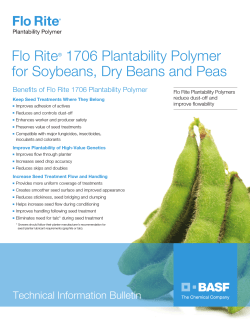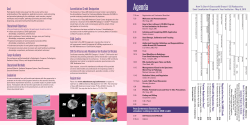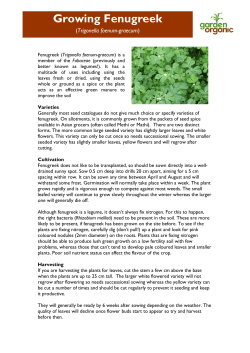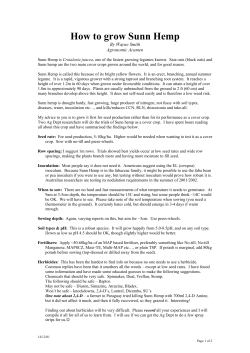
Quality vs. Quantity - How
Quality vs. Quantity - How
to decipher a seed label.
One of the most common misconceptions made by turf
professionals and homeowners alike is the idea of “Seed
is Seed, as long as it grows and is green”. This idealism
is one that can make or break those managing turf as a
profession, and in the long run cost companies unneeded
maintenance expenses.
When buying seed, it is extremely important to pay close
attention to the seed label(s). Learning to read a seed tag
can help you determine if you are truly receiving value
and help you avoid future problems and expense.
• First, it is important to determine if the seed is of a single variety (one name on the label) or is a mixture or
blend (two or more names on the label).
• Secondly, note if you are buying an improved, (turftype) variety such as Bonsai 3000 Tall Fescue or just a
common (non turf-type) variety such as Fawn Tall
Fescue.
• Some labels will even state “variety not stated” which
is an indication of lesser quality. The turf quality of
many varieties of grass seed can be referenced through
SEED LABEL IDENTIFICATION
#%# -)*'0"$%' $ + *"+' ).2
$) . $"%)$*#'
$%').&$+' ).$# &&" "2
$ )( +' ). (&'%))'%#
*$*)%' /(&'%*) %$2
F%%)').&(%())''%,$(
'%&2%*""(()$<2?;F2
%*""(()$;2<?F2
$ )(,')(,(&'%*2
%)84<=<?@
$ ).'$$ ".'((7
>>2C? +$ $'$$ ".'((7
>>2C? *.
$)*!."*'((7 C2A; '%%!",$
$)*!."*'((7
C2A; '& $(* C2A; 7'%))4$*)%' /'%&) %$'% )
F <2=? F
F ;2<; 1
1@3<= 1<<3<>
00C;;B@
F%&*'(%)).& $)# -)*'2
C;
C;
B?
B?
C;
F'# $) %$%)).& $)
# -)*'2
F$')#))' $)# -)*'0*(*"".
"(()$=F*$"((( (%)2
<2@?
"".) ()-& ') %$%)
'# $) %$)()$$+'.#%$
())(2
)%'# $) %$)()5(62
#%""'2*()+" $()%(""(2
1415 East 6th Street • P.O. Box 21488 • Los Angeles, California 90021
Phone: (213) 626-9668 • Toll-Free: (800) 621-0315 • Fax: (213) 626-4920
www.stoverseed.com
trials conducted by the National Turfgrass Evaluation
Program www.NTEP.org.
After confirmation of variety, check for percent purity.
Depending upon the number of varieties on the label
there may be multiple entries for purity. In any event,
these purity numbers should add up to as close to 100
percent as possible.
Total purity of 98 percent or greater is considered excellent quality. A seed lot of less than 98 percent or a seed
mixture that adds up to less than 98 percent can be of
good quality depending on the percent of weed and crop
seed (see below). The germination number represents the
percentage of seed that can be expected to germinate and
establish.
Good quality seed can be expected to have a germination
range of 80 to 90 percent depending upon the type of
grass. The germination percentage is determined by a
seed laboratory and the test must be conducted within a
certain time period, usually within the last 12 to 15
months. This is noted on the tag under “Tested” (date of
germination test) and “Sell by” which is the expiration
date of the test.
Seed can be retested for germination percentage upon expiration but the seed must be relabeled with the new test
results. You should not purchase any seed whose germination has expired beyond the “Sell by” date.
At the bottom of the seed label are three important parts:
Crop Seed, Inert Matter and Weed Seed percentages.
”Inert Matter” notes the percentage of inert matter in the
mix. Inert is usually parts of the plant that escaped the
cleaning process such as chaff, stems or hulls and is usually in the 2 to 5 percent range. However some seeds can
be coated or treated and have inert percentages in the 50
to 80 percent range and this is listed on the label. Some
lots of seed can also contain a high percentage of inert
matter such as dried mulch or other organic matter for
use in spreading the seed. Again this is listed on the label
and should be factored in computing the actual cost of the
seed. If the seed cost $5.00 a pound but has 50% coating
or inert matter then the actual cost of pure seed is about
$10.00/lb ($5.00/.50=$10.00).
“Weed Seed” is fairly self-explanatory and should be
0.15% or less. Again, consult the lab test if you have
any concerns. Noxious weed seeds are classified as
“economically troublesome” and are generally prohibited in a seed mix. The types of noxious weeds vary
from state to state and even from county to county. The
state agriculture department maintains a list of prohibited noxious weeds within that state and is usually available online. Other information on the label is the name
of the labeler or seed company which must hold a valid
license to sell seed and the “Origin” of the seed or where
it was produced.
While this will serve as a guide to understanding a seed
label, keep in mind that a seed dealer’s reputation rides
on every label that is attached to a package of seed that is
sold. Your assurance of the accuracy of the label to what
is in the bag rests with the reputation and integrity of the
seed dealer.
“Crop Seed” is the percentage of seed of another crop.
For example Ryegrass is considered crop seed if it is
found in Tall Fescue and vice versa. There is usually a
small percentage of crop seed in most seed lots and it is
not of concern unless it gets above 1.50%. In any case
your seed dealer can tell you what the crop seed is by reviewing the lab test that lists the type and amount of crop,
weed and inert matter in a lot of seed.
1415 East 6th Street • P.O. Box 21488 • Los Angeles, California 90021
Phone: (213) 626-9668 • Toll-Free: (800) 621-0315 • Fax: (213) 626-4920
www.stoverseed.com
© Copyright 2025





















